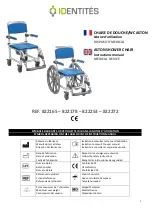
7
METHOD 2 - This method requires two (2) assistants.
The second assistant should be positioned at the front
of the HTR lifting upward on a non-removable (non-
detachable) part of the HTR frame when lifting the HTR
and stabilizing the HTR when the HTR is being lowered
to the ground.
The first assistant should stand on the sidewalk and turn
the HTR so that the rear wheels are against the curb.
The HTR should be tilted back to the balance point and,
in one continuous upward movement, the rear wheels
should be pulled up and over the curb. DO NOT return
the front casters to the ground until the HTR has been
pulled backward far enough for the front casters to clear
the edge of the curb.
G
E
N
E
R
A
L
G
U
I
D
E
L
I
N
E
S
PROCEDURE 1
GENERAL GUIDELINES
WARNING
Invacare does not recommend traversing curbs
with the HTR. However, extreme caution is advised
when it is necessary to move an occupied HTR up
or down a curb. Make sure to use ONLY secure,
non-detachable parts for hand-hold supports.
When tilting the HTR,
an assistant should grasp the back of
the HTR on a non-removable (non-detachable) part.
Inform the HTR occupant before tilting the HTR and remind
him/her to lean back. Be sure the occupant’s feet and hands
are clear of all wheels.
After mastering the techniques of tilting the HTR, use
this procedure to tackle curbs, short stairs, etc.
METHOD 1 - Apply a continuous downward motion until
the balance point is achieved and the front casters clear
the curb. At this point, the assistant will feel a difference
in the weight distribution.
Roll the HTR forward and slowly lower the front casters
onto the sidewalk. Do not let the HTR drop the last few
inches to the ground. This could result in injury to the
occupant. Push the HTR forward until the rear wheels
roll up and over the curb.
Stairways
WARNING
DO NOT move an occupied HTR up or down a
stairway. Otherwise, injury may occur.
ESCALATORS? SORRY!
DO NOT use an escalator to move the HTR
between floors. Serious bodily injury may occur.
During independent transfer, little or no seat platform will
be beneath you. Use a transfer board if at all possible.
Transferring to and From Other Seats
NOTE: This activity may be performed independently
provided the user has access to the wheellocks and has
adequate mobility and upper body strength.
WARNING
BEFORE attempting to transfer in or out of the
HTR, every precaution should be taken to
reduce the gap distance. Turn both casters
parallel to the object you are transferring onto.
Also be certain the wheel locks are engaged
to help prevent the wheels from moving.
CAUTION
When transferring, position yourself as far back
as possible in the seat. This will prevent damaged
upholstery and the possibility of the HTR tipping
forward.
Position the HTR as close as possible along side the seat
to which you are transferring, with the front casters
pointing parallel to it. Engage wheel locks. Shift body
weight into seat with transfer.

































